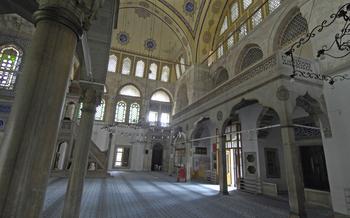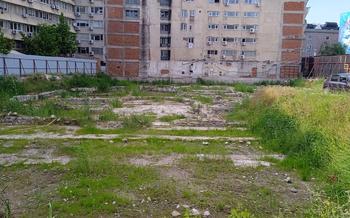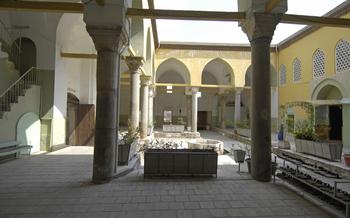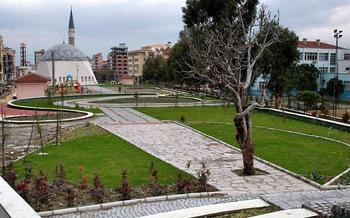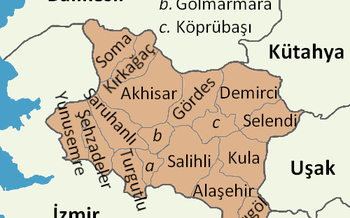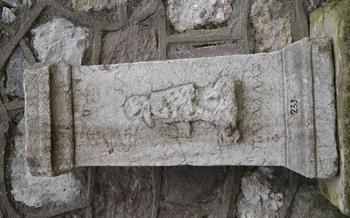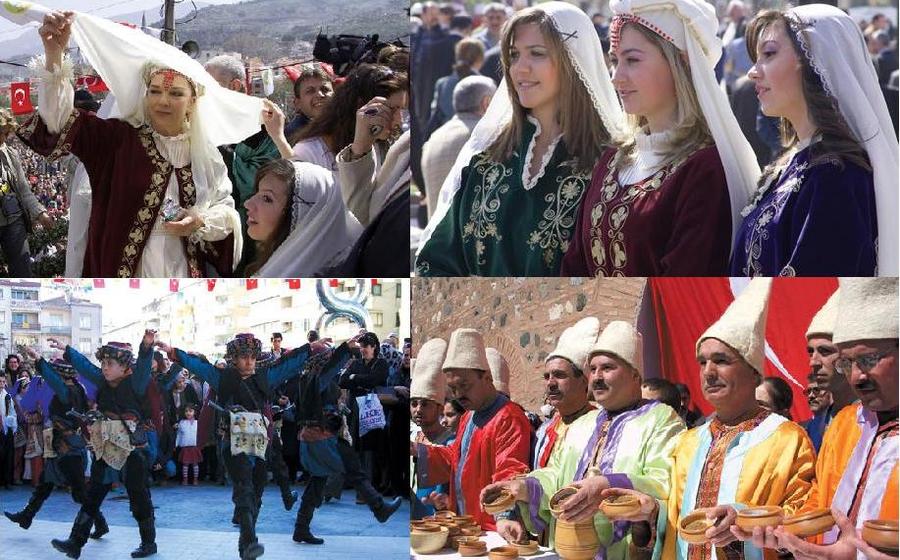
Museum of the Princes' City of Manisa
- Manisa’s Princes' City Museum
- History of the Museum
- Architecture of the Museum
- Collections of the Museum
- Exhibitions at the Museum
- Educational Programs at the Museum
- Visitor Information
- How to Get to the Museum
- What to See and Do Nearby
- Tips for Visiting the Museum
- History of Manisa
- Culture of Manisa
- Economy of Manisa
- Geography of Manisa
- Insider Tip
Manisa’s Princes' City Museum
The Museum of the Princes' City of Manisa is a historical museum dedicated to the history of the city of Manisa and its significance as the capital of the Saruhanid Beylik, a beylik of the Beylik period. It was founded in 1983 and is located in the historical city center of Manisa, in the Saruhan Mosque complex. The museum showcases a rich collection of artifacts that offer insights into the city's past, including archaeological finds, manuscripts, and ethnographic objects. Among the highlights of the museum are the impressive collection of coins, the well-preserved examples of Islamic calligraphy, and the stunning collection of traditional Turkish handicrafts.
History of the Museum
The Museum of the Princes' City of Manisa was established in 1984 to preserve and showcase the rich history and culture of Manisa, which served as the capital of the Saruhanids, a beylik that ruled over the region during the 14th and 15th centuries, and later as the sanjak center of the Ottoman Empire. The museum was founded at the initiative of a group of local historians and archaeologists who recognized the importance of preserving the city's heritage.
The significance of Manisa as a city of princes lies in its role as a center of education and culture during the Ottoman period. Manisa was home to a number of palaces and mansions belonging to the Ottoman princes, who were sent to the city to receive their education and training. This period of history, known as the "Princes' Period," left a lasting legacy on the city's architecture, culture, and traditions.
The establishment of the museum was a significant step in preserving and promoting this legacy. The museum's collection includes a wide range of artifacts from the Princes' Period, including manuscripts, paintings, ceramics, and textiles. These artifacts provide valuable insights into the lives and times of the Ottoman princes and the cultural and intellectual atmosphere of Manisa during this period.
Today, the Museum of the Princes' City of Manisa is a major tourist attraction and an important center for research and education. It plays a crucial role in preserving and promoting the rich history and culture of Manisa, and serves as a reminder of the city's significant role in the history of the Ottoman Empire.
Architecture of the Museum
The Museum of the Princes' City of Manisa is housed in a magnificent building that is a testament to the city's rich history. The museum building was originally constructed in the 16th century as a palace for the princes of the Ottoman Empire. The palace was designed by the renowned architect Mimar Sinan, who was responsible for many of the most famous buildings in the Ottoman Empire.
The museum building is a beautiful example of Ottoman architecture. It is constructed from white stone and features a variety of intricate carvings and decorations. The building is also surrounded by a lush garden, which provides a peaceful and relaxing setting for visitors.
The museum's architecture is a reflection of the history of Manisa. The building was originally constructed as a palace for the princes of the Ottoman Empire, and it served as a royal residence for over 400 years. The building's design and decoration reflect the wealth and power of the Ottoman Empire, and it is a reminder of the city's important role in Ottoman history.
Today, the Museum of the Princes' City of Manisa is a popular tourist attraction. The museum's architecture is one of its main highlights, and visitors can admire the beautiful carvings and decorations that adorn the building. The museum's garden is also a popular spot for visitors to relax and enjoy the scenery.
Collections of the Museum
The Museum of the Princes' City of Manisa houses a vast and diverse collection of artifacts that offer a glimpse into the rich history and culture of Manisa. These artifacts include:
-
Archaeological artifacts: These artifacts date back to the Neolithic period and include pottery, tools, and weapons. They provide valuable insights into the early history of the region and the development of human civilization in Manisa.
-
Ethnographic artifacts: The museum also houses a collection of ethnographic artifacts that showcase the traditional customs and practices of the people of Manisa. These artifacts include clothing, jewelry, and household items, and they provide a glimpse into the daily lives of the people who lived in the region.
-
Manuscripts and books: The museum has a significant collection of manuscripts and books that date back to the Ottoman period. These books cover a wide range of topics, including history, religion, and literature, and they provide valuable insights into the intellectual and cultural life of Manisa during the Ottoman period.
-
Paintings and sculptures: The museum also houses a collection of paintings and sculptures that depict the history and culture of Manisa. These works of art provide a visual representation of the region's past and offer visitors a deeper understanding of its artistic heritage.
These artifacts are displayed in a variety of galleries and exhibits, each of which focuses on a different aspect of the history and culture of Manisa. Visitors can explore these galleries and exhibits to learn more about the region's past and its people.
Exhibitions at the Museum
The Museum of the Princes' City of Manisa hosts a variety of exhibitions throughout the year. These exhibitions showcase the museum's collection of artifacts and highlight different aspects of the history and culture of Manisa. Some of the past exhibitions have focused on the history of the city, the lives of the princes, and the development of the region's traditional arts and crafts. The museum also hosts temporary exhibitions that feature the work of contemporary artists and artisans.
The current exhibitions on display at the museum include:
-
The Princes of Manisa: A Legacy of Power and Culture This exhibition explores the history of the princes of Manisa and their role in the development of the city. It features artifacts from the museum's collection, including portraits, documents, and personal belongings of the princes.
-
Manisa: A Crossroads of Cultures This exhibition highlights the diverse cultural influences that have shaped Manisa over the centuries. It features artifacts from different periods of history, including the Ottoman, Byzantine, and Roman periods.
-
The Art of Manisa This exhibition showcases the traditional arts and crafts of Manisa. It features a variety of objects, including textiles, ceramics, metalwork, and jewelry.
The Museum of the Princes' City of Manisa is a great place to learn about the history and culture of this fascinating city. The exhibitions are well-curated and informative, and they offer a unique glimpse into the lives of the princes and the people of Manisa.
Educational Programs at the Museum
The Museum of the Princes' City of Manisa offers a variety of educational programs designed to engage and educate visitors of all ages. These programs are designed to provide a deeper understanding of the history, culture, and art of Manisa.
School Programs: The museum offers guided tours and workshops for school groups. These programs are tailored to the specific needs of the students and can be customized to fit any curriculum.
Family Programs: The museum also offers family-friendly programs such as storytelling sessions, art workshops, and scavenger hunts. These programs are a great way for families to learn together and have fun.
Adult Programs: The museum offers a variety of adult programs, including lectures, workshops, and film screenings. These programs are designed to provide adults with opportunities to learn about the history, culture, and art of Manisa.
How to Participate: To participate in the educational programs at the Museum of the Princes' City of Manisa, visitors can contact the museum's education department. The museum's website also provides information about upcoming programs and how to register.
Benefits of Participating: Participating in the educational programs at the Museum of the Princes' City of Manisa offers a number of benefits, including:
- Increased knowledge and understanding of the history, culture, and art of Manisa.
- Opportunities to engage with museum staff and other visitors.
- A fun and interactive way to learn.
- A chance to make new friends and memories.
Visitor Information
The Museum of the Princes' City of Manisa is open to the public from Tuesday to Sunday, from 8:30 am to 5:30 pm. It is closed on Mondays. Admission to the museum is 20 Turkish lira for adults, 10 Turkish lira for students, and free for children under the age of The museum offers a variety of discounts for groups, seniors, and disabled visitors.
The museum is accessible by public transportation. Visitors can take the Manisa-Salihli train to the Manisa station, and then walk to the museum, which is about 1 kilometer away. Alternatively, visitors can take the Manisa-Afyonkarahisar bus to the Manisa bus station, and then take a taxi or bus to the museum.
There is a parking lot available at the museum for visitors who arrive by car. The parking lot is free of charge.
The museum offers a variety of amenities for visitors, including a gift shop, a café, and a restaurant. The gift shop sells a variety of souvenirs, including books, postcards, and replicas of artifacts from the museum's collection. The café serves a variety of hot and cold drinks, as well as snacks. The restaurant serves a variety of traditional Turkish dishes.
How to Get to the Museum
The Museum of the Princes' City of Manisa is located in the city of Manisa, Turkey. The museum is situated in the central part of the city, near the Manisa Grand Mosque. To get to the museum, visitors can take public transportation or drive their own car.
Public Transportation
There are several bus lines that stop near the museum. Visitors can take any bus that stops at the Manisa Grand Mosque and then walk a short distance to the museum.
Car
Visitors who are driving to the museum can take the D550 highway to Manisa. The museum is located on the right-hand side of the highway, just before the Manisa Grand Mosque.
Parking
There is a small parking lot available at the museum. The parking lot is free of charge.
What to See and Do Nearby
The Museum of the Princes' City of Manisa is located in the heart of the city, within walking distance of many other attractions. Visitors can explore the historic city center, with its narrow streets, traditional Ottoman houses, and lively bazaars. The Manisa Museum, located just a few minutes from the Princes' City Museum, houses a collection of artifacts from the region's rich history. The Manisa Grand Mosque, built in the 16th century, is a beautiful example of Ottoman architecture. For a taste of local culture, visitors can visit the Manisa Bazaar, where they can find everything from fresh produce to handmade crafts.
There are several restaurants and cafes located near the museum, offering a variety of Turkish and international cuisine. Visitors can enjoy traditional dishes such as kebabs, pide, and gözleme, as well as international favorites like pizza, pasta, and burgers.
For those looking to stay overnight, there are a number of hotels and guesthouses located within walking distance of the museum. Visitors can choose from a variety of options, ranging from budget-friendly hostels to luxurious hotels.
In addition to the attractions located near the museum, there are many other things to see and do in Manisa. Visitors can explore the city's many parks and gardens, visit the local museums, or take a boat trip on the Manisa River. For a unique experience, visitors can take a hot air balloon ride over the city, offering stunning views of the surrounding countryside.
Tips for Visiting the Museum
-
Best time to visit: The best time to visit the Museum of the Princes' City of Manisa is during the spring or fall, when the weather is pleasant. The museum is open every day except Mondays, from 8:30 AM to 5:00 PM.
-
Duration of visit: Plan to spend at least two hours exploring the museum's exhibits. If you are particularly interested in the history of Manisa, you may want to allow even more time.
-
Dress code: There is no specific dress code for visiting the museum, but it is always a good idea to dress respectfully.
-
Things to avoid: Do not touch or lean on the exhibits. Do not take photos with flash. Do not eat or drink in the museum. Do not bring pets into the museum.
History of Manisa
Manisa, with its rich history dating back to ancient times, boasts a captivating narrative. Founded during the Bronze Age, it saw the rule of various civilizations, including the Hittites, Lydians, and Persians. Alexander the Great conquered the city in 334 BC, ushering in a new era. In the 13th century, Manisa became part of the Beylik of Saruhan, a precursor to the Ottoman Empire.
The city flourished under Ottoman rule, becoming the sanjak center of the Saruhan Sanjak. In the 15th century, it served as the capital of the Ottoman Empire for a brief period. During this time, Manisa was renowned as a center of learning and culture, attracting scholars and artists from across the empire.
The city's strategic location on the Silk Road contributed to its prosperity. Merchants and travelers from various cultures converged in Manisa, fostering a vibrant exchange of ideas and goods. The city's diverse population, including Greeks, Armenians, and Jews, added to its rich cultural tapestry.
Manisa's history is intertwined with the lives of influential figures, including the Ottoman sultans who spent their formative years in the city as princes. These princes, known as Şehzade, received their education and training in Manisa, preparing them for their future roles as rulers.
In the 19th century, Manisa underwent significant modernization efforts. The city's infrastructure improved, and new industries emerged. However, the Greco-Turkish War and the subsequent Turkish War of Independence brought challenges to the region.
Today, Manisa stands as a modern and vibrant city, preserving its rich historical legacy while embracing progress. Its historical sites, cultural attractions, and natural beauty continue to captivate visitors from around the world.
Culture of Manisa
Manisa is a city with a rich and diverse culture. Its unique location at the crossroads of different civilizations has led to a vibrant blend of traditions, customs, and beliefs. The city's culture is deeply rooted in its history, and its people are proud of their heritage.
One of the most notable aspects of Manisa's culture is its traditional cuisine. The city is famous for its delicious dishes, which often feature fresh local ingredients and unique flavors. Some of the most popular dishes include Manisa kebabı, a grilled meat dish, and Manisa pide, a type of flatbread filled with cheese and herbs.
Another important aspect of Manisa's culture is its traditional crafts. The city is home to a number of skilled artisans who create beautiful handmade products, such as carpets, pottery, and jewelry. These products are often sold in local markets and shops, and they make for great souvenirs.
Manisa is also a city with a strong sense of community. The people of Manisa are known for their hospitality and their love of festivals and celebrations. Throughout the year, the city hosts a number of events that bring people together, such as the Manisa Grape Festival and the Manisa International Music Festival.
Overall, Manisa is a city with a rich and vibrant culture. Its people are proud of their heritage and traditions, and they are always welcoming to visitors. If you are looking for a city with a unique and authentic culture, then Manisa is the perfect place for you.
Economy of Manisa
Manisa's economy is largely based on agriculture. The city is known for its production of grapes, olives, and figs. Manisa is also a major producer of tobacco and cotton. In addition to agriculture, Manisa has a growing industrial sector. The city is home to a number of factories that produce textiles, food products, and machinery. Manisa is also a major center for trade and commerce. The city's strategic location on the Aegean Sea has made it a hub for trade between Turkey and Europe.
The unemployment rate in Manisa is relatively low. The city's strong economy and growing industrial sector have helped to create a number of jobs for residents. Manisa is a relatively prosperous city with a high standard of living. The city offers a variety of amenities and services, including excellent schools, hospitals, and shopping centers.
Manisa is a city with a strong and diverse economy. The city's agricultural sector, industrial sector, and trade and commerce sector all contribute to its economic success. Manisa is a city with a bright economic future. The city's strong economy and growing industrial sector are expected to continue to create jobs and opportunities for residents in the years to come.
Geography of Manisa
Manisa is located in the Aegean region of Turkey. It is bordered by the provinces of İzmir to the west, Balıkesir to the north, Kütahya to the east, and Aydın to the south. The province has a total area of 13,120 square kilometers.
The climate of Manisa is Mediterranean, with hot, dry summers and mild, wet winters. The average temperature in January is 5°C (41°F), while the average temperature in July is 25°C (77°F).
The major mountains in Manisa are the Bozdağ Mountains, which run along the northern border of the province. The Gediz River, the longest river in the province, flows through the center of Manisa. The Gördes Lake is the largest lake in the province.
The major cities and towns in Manisa are Manisa (the provincial capital), Akhisar, Soma, Kula, and Demirci.
Insider Tip
-
Little-known fact: The Museum of the Princes' City of Manisa is home to a secret garden that is not open to the public. The garden is said to be filled with beautiful flowers and plants, and it is a popular spot for the museum's staff to relax and take a break.
-
Hidden gem: One of the hidden gems of the museum is the collection of Ottoman calligraphic manuscripts. These manuscripts are beautifully written and illuminated, and they provide a glimpse into the history of Islamic art and culture.
-
Unique experience: Visitors to the museum can have a unique experience by taking part in a traditional Turkish coffee ceremony. The ceremony is held in the museum's café, and it is a great way to learn about Turkish culture and hospitality.
-
Great place to eat or shop: There are a number of great places to eat and shop near the museum. For a traditional Turkish meal, visitors can try one of the many restaurants in the nearby bazaar. For souvenirs, visitors can find a variety of handmade crafts and textiles in the shops around the museum.

